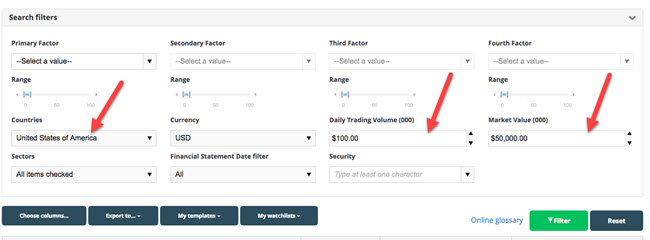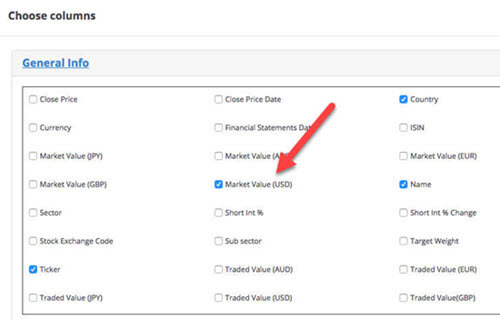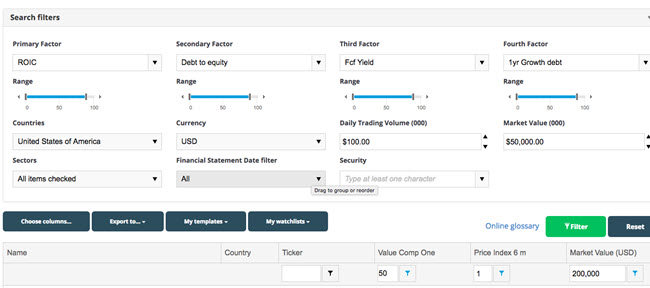Quality Adjusted Value Microcap Investment Strategy - O'Shaughnessy
Estimated Reading Time: 7 minutes
Discover how you can achieve outstanding returns by using a proven microcap investment strategy. This article breaks down a back-tested approach that yielded 20.3% annual returns over 34 years.
You'll learn why microcap stocks, often overlooked by big investors, can be a goldmine for individual investors like you.
The post guides you step-by-step on how to identify quality microcap stocks using key financial ratios. By the end, you'll know exactly how to implement this strategy in your portfolio, leveraging undervalued stocks with strong momentum for optimal returns.
First an short introduction to microcap investing.
In the stock market you can say that one man’s trash is another man’s treasure. In the research paper Microcaps — Factor Spreads, Structural Biases, and the Institutional Imperative (August 2017) O'Shaughnessy Asset Management (OSAM) makes a convincing argument that this is true.
The “Junkyard” Microcap Universe - $50 to $200m market value
Microcap stocks were defined as companies with a market value between $50 million to $200 million have traditionally been seen as a “junkyard” by institutional investors, mainly for two reasons:
- Professional money managers – and most investors - think that microcap equities consist of high risk weak companies with poor financial health.
- Because these companies are so small, big investors with billions to invest cannot invest in them.
This is good news for investors like you and me, this “junkyard” of microcap stocks contains jewels among the junk.
We show you exactly how to do it – step by step
To find out how you can find the same ideas they come up with for your own portfolio keep reading for detailed step by step instructions.
What are Microcap companies?
Microcap companies are defined by O’Shaughnessy to be companies with a market value between $50 million to $200 million. Because these companies are so small, they are neglected by big investors and have little to no coverage by analysts.
As mentioned, this is all good news for you and me as this neglect gives us the chance to earn large returns from this unloved sector of the market.
Before we dive into the actual strategies and the returns, let me give you more information about the people behind the research.
Click here to start using this Microcap strategy in your portfolio Now!
Who was the research team?
The research was done by O'Shaughnessy Management, a quantitative investment management firm with around $6.2 billion of assets under management. The seven person research team includes the CEO and six CFAs.
They performed this research to show that high returns could be made from investing in microcap stocks.
The researchers are all in-house analysts without any explicitly stated conflicts of interest. Since the paper appears to be for the benefit of individual investors, there does not seem to be any potential conflicts of interest. At the moment they do not even have a Microcap fund.
We can trust this research.
Hey what about bias in the back test?
Look-ahead bias
These are experiences researchers so even though they did mention using information that would have been publicly available at the time of investing in a stock, I am sure they automatically did this.
However they did mention that the models constructed “may have been designed with the benefit of hindsight”. I assume this refers to the ratios and indicators they used to select quality microcap companies.
Survivorship bias
Returns could be artificially inflated if companies that went bankrupt were not included in the backtest.
To avoid this, the universe of small and large capitalization stocks consisted of all securities in the Chicago Research in Security Prices (CRSP) dataset or S&P Compustat Database with an inflation-adjusted market capitalization of $200 million when they were selected each year.
This is a high quality database where bankrupt companies will most likely also be included. Also if you look for higher quality companies the risk of survivorship bias is smaller because high quality companies may not go bankrupt as often as bad quality companies.
That said when testing Microcap companies over long periods of time the chance of survivorship bias creeping in is high; it all depends on the quality of your data source.
The back test criteria
Back test period (34 years) and first layer of market universe filtering
The research team wanted to make sure that the results they found did not just apply to a few years. They performed their back tests over a 34 year period from 1982 – 2016, a period with three major stock market crashes in the U.S., so you can know that the strategies have been tested in good and bad markets.
$50 million to $200 million market value
The back test universe started with all microcap companies (market value $50 million - $200 million) trading on U.S. exchanges.
Only US registered companies
When this universe was filtered to include only companies incorporated in the USA it left around 1,300 microcap companies with a total market value of about $100 billion dollars which made up only 0.4% of the total U.S. stock market capitalization. As you can see this is just about nothing!
The total average daily traded value was $700,000.
Here you can clearly see why large investors have no interest in this market.
Daily average traded value more than $100,000
As transaction costs in the form of market impact and bid-ask spreads are higher for companies with lower daily average volume. For this reason only companies with a minimum daily average traded value of $100,000 were selected.
This should be fine for private investors like us.
This liquidity requirement reduced the back test universe to around 500 companies.
As you will see shortly this universe will further reduced by only selecting quality microcap stocks.
Lower liquidity reduced returns - This is important!
What surprised me was that by choosing only companies that had a $100,000 daily average value, average yearly returns improved by 0.8% over 34 years – this is substantial.
Click here to start using this Microcap strategy in your portfolio Now!
Characteristics of this microcap universe
In order to develop the best investment strategy the researchers first wanted to find out just what type of companies are mainly found in the microcap investment universe.
When they just looked at the average 3-year sales growth for both microcap and largecap companies they were roughly the same. However just looking at the averages was not helpful because there was much wider range in sales growth for microcap stocks than for largecap stocks.
With further analysis the researchers divided microcap stocks into the following three categories:
- Steady State Firms
- New Ventures
- Fallen Angels
Steady State Firms
59% of these microcaps were ‘steady state’ firms that are defined as companies that had a steady market capitalization of $50 - $200 million for over 3 years. Many of these steady state firms are commercial banks and thrift stores.
Partly due to the low volatility and high returns of banks, steady state firms had the highest average return of the 3 categories at 10.1% annually.
New Ventures
These companies represented about 25% of the microcap universe, and were new companies that just began generating sales. These were often biotechnology or software start-ups recently increased their market capitalization to between $50 - $200 million.
This was the worst performing category with the highest volatility out of all 3 groups. New ventures returned only 4.7% annually with 27.8% volatility.
Fallen Angels
Fallen angels were the smallest group of companies that made up only 16% of our microcap universe. These companies are defined as former largecap companies that have hit hard times and have declined in market value to below $200 million.
Fallen angels delivered an average return of 8% with a volatility of 27.4%.
How to find quality companies in the “junkyard”
The microcap universe is littered with companies that are not profitable, generating negative cash flow, and are taking on unsustainable amounts of debt.
These are companies you want to avoid and that is why the researchers narrowed the microcap universe by filtering for “quality-adjusted” microcap stocks.
They removed all companies in the bottom 10%
To do this they removed companies that fell in the bottom 10% of the following five ratios or indicators:
1. Change in Net Operating Assets (NOA = Operating Assets - Operating Liabilities)
Change in Net Operating Assets (NOA) is a measure of the level of assets a company needs to run its business. The average change in NOA for our microcap universe was 44.3%, much higher than their largecap counterparts.
Moderate levels of a change in NOA signal a business than can handle organic business growth without having to invest large amounts by for example taking on a lot of debt.
The 10% of microcap companies with the biggest increase in NOA were eliminated from the universe.
2. Debt to Equity Ratio
A high debt to equity ratio raises concerns if the company will be able to pay off its debt. The 10% of microcap companies with the highest debt to equity ratio were eliminated from the universe.
3. 1-Year change in debt
The average one year change in debt of the universe was 32.6%. A large increase in debt signals that the business may be struggling to finance its operations from cash the business generates or that it is growing very fast.
The 10% of microcap companies with the largest increase in debt were eliminated from the universe.
4. Return on Invested Capital (ROIC)
Return on invested capital is a measure at how effective a company is at turning capital into profits. A higher ROIC tells us that company management is investing in profitable projects.
The 10% of microcap companies with the lowest ROIC were eliminated from the universe.
5. Free cash flow yield
Free cash flow is the amount of cash from operations remaining after deducting capital expenditure. Free cash flow yield divides this value by the market cap of the company.
A positive free cash flow yield means a company can sustain itself, while a negative free cash flow yield means a company needs money (debt or capital) to have enough cash to stay in business. The 10% of microcap companies with the lowest Free Cash Flow yield were eliminated from the universe.
The number of companies remaining after filtering for quality was not mentioned.
Yearly re-balancing with equal weight portfolios
The portfolios were re-balanced yearly and the portfolios were equal-weighted.
This means if a $50 million company was 1% of the portfolio, then a $200 million company would also be 1% of the portfolio.
Costs of buying and selling Microcap companies
As you know high trading costs can quickly make even the most attractive strategy look bad if the cost of implementing it is too high.
Costs you must look out for are:
- Commissions,
- Market impact,
- Bid-ask spreads.
In the USA commissions are very low and can be generally ignored. Depending on the amount you decide to allocate to this strategy, the market impact will vary. For private investors like us and the individual investments we make bid ask spreads will be a cost but it should not be a problem.
All performance results did not include transactions costs, investment management fees, taxes, or any other costs.
Click here to start using this Microcap strategy in your portfolio Now!
What were the returns?
First they compared microcap companies to large stocks and if their adjustments for quality helped returns at all.
Large stocks were defined as American companies with a market capitalization greater than the average capitalization for the total market (currently those stocks above an inflation-adjusted $7 billion market cap).
As you can see all microcap companies did not do better than large companies BUT quality microcap companies did do a lot better.
Quality adjusted microcap securities have an annualized return of 14.2%, compared to the 12% return by large stocks.
This is a huge improvement because remember this is the average yearly return over a 34 year test period!

Click image to enlarge
Backtest period: 1982-2016
Source: Microcaps — Factor Spreads, Structural Biases, and the Institutional Imperative (August 2017).
What Investment Strategies were tested?
Returns of quality-adjusted group of microcap companies were tested using the following investment strategies:
- Value,
- Momentum,
- Financial strength,
- Earnings quality, and
- Earnings growth.
The authors did not define the factors or say what ratios they used to select the companies.
Testing the investment strategies by company size
The researchers also tested what your returns would have been if you applied various investment strategies to companies grouped by size.
Large cap was defined as $7 billion or higher market value and small cap as ($200 million to $7 billion market value) companies.
The researchers took the top 10% of stocks filtered on a factor (value for example) and subtracted those returns from the annual returns of the lowest 10% of stocks filtered on that same factor. For example, undervalued returns minus overvalued returns.
This difference is the theoretical return you could earn if you went long the stocks in the top decile and shorted the stocks in the lowest decile.
Value and Momentum were the most compelling factors

Click image to enlarge
Source: Microcaps — Factor Spreads, Structural Biases, and the Institutional Imperative (August 2017).
The biggest difference was for microcap stocks (the whole universe not just the quality companies) with a value strategy was 28.2% on an average annual basis over 34 years – this is nearly unbelievable.
A long short strategy does not work with microcaps
But this spread assumes that it is practical to short microcap stocks. This is often not possible due to liquidity issues, and so the real return you can earn will be lower (but still a LOT higher than just investing in the market).
Click here to start using this Microcap strategy in your portfolio Now!
Returns of quality-adjusted microcaps - Long only
Here are the returns for quality-adjusted microcaps if you used a value and momentum investment strategy (the two strategies with the highest returns from the above table).
These returns were calculated if you went long only – this means buying only the best companies according to the strategy.

Click image to enlarge
Source: Microcaps — Factor Spreads, Structural Biases, and the Institutional Imperative (August 2017).
Quality adjusted Microcap Value won – BY FAR
As you can see the winning strategy – by far – was quality adjusted Microcap value.
Not only did it have the highest average return of 20.3%, over 34 years from 1982 – 2016, the volatility was not much more than that of Large Cap stocks. This means they had the highest risk adjusted returns – the highest Sharpe Ratio of 0.78.
The second best strategy – with a bit lower returns (17.8%) and slightly higher volatility was quality adjusted Microcap momentum. It was also the strategy with the second best risk adjusted return.
The perfect strategy for you and me
I hope these results let you completely get rid of the idea that quality adjusted Microcap companies are junk companies.
Just think about it:
- They perform better than large companies,
- Large investors cannot invest in them
which means they are the ideal investment strategy for small investors like you and me.
The best strategy for you to implement
Now we get to the interesting part of this article – where I show you exactly how to implement the results of this research in your portfolio.
This is what we learned from the research:
- Value and momentum quality-adjusted microcap stocks deliver the highest returns relative to risk.
- Although the researchers did not touch on it in the paper, you can earn great returns by combining value and momentum in one strategy. This means looking for undervalued companies (value) with an upward moving share price (momentum).
- Filtering stocks based on earnings quality or financial strength does not help returns so we can leave them out. Remember they were the factors that added the least to returns – see the above table.
- Finally avoid large cap stocks and stick to the quality adjusted microcap universe.
- This is the space in the market where small investors like me and you have a big chance at earning great returns and outperform the big money managers.
Click here to start using this Microcap strategy in your portfolio Now!
How to implement this microcap strategy with the stock screener
Everything you need to implement the best ideas from the research paper is already built into the stock screener.
This is how you do it.
First select Microcap Stocks in the United States
Our edge as small investors is in the microcap universe so we want to make sure that we are selecting only small companies.
For this, we first set the minimum market cap as $50 million.
Since these companies are small, you make sure ensure that you can easily buy them so set at least a $100,000 daily trading value.
The strategies tested in the paper only used US stocks, so we only selected companies registered in the USA. You can of course select all the countries where you like to invest.

Click image to enlarge
Next, we set the maximum market cap as $200 million.
Click the Choose columns button then select Market Value (USD).

Click image to enlarge
Then in the column filter type in 200,000 (remember numbers are entered as thousands), then click on the funnel icon and select smaller than.

Click image to enlarge
Adjusting your microcap universe for quality
Remember we are looking for the jewels among the junkyard, so we need to choose only quality-adjusted microcap stocks.
We do this using the following 4 ratios and indicators:
- Return on Invested Capital
- Debt to Equity
- Free Cash Flow Yield
- 1 Year Debt Growth
Remember with these settings you want to remove the worse 10% of companies, just like the researchers did. That is why you should set the sliders to ignore the bottom 10% of companies in each case.

Click image to enlarge
Select microcap stock with Value and Momentum
O’Shaughnessy found that value and momentum stocks produced the best return. In order to select stocks that are at a bargain and exhibit positive momentum, we use:
- Value Composite One and
- Price index 6 month
The Value Composite One is a group of value indicators that was also developed by O’Shaughnessy. The scale ranges from 0 -100, and lower numbers represent undervalued companies.
The price index 6 month is calculated by taking the current share price and dividing it by the share price 6 months ago.
We set Value Composite One to less than or equal to 50. We set 6 month price index to greater than or equal to 1.
You can sort Value Composite One from low to high (to do this simply click on the column heading), so the most undervalued companies appear first.

Click image to enlarge
That is all you have to do.
The list of stocks the screener produces are all quality-adjusted microcap stocks with good value and strong positive momentum.
This is what your final screen should look like.

Click image to enlarge
That is all you need to do
That is all you need to do to enjoy the returns that big institutional investors cannot touch and only dream about!
PS Everything you need to implement this investment strategy in your portfolio can be found here.
PPS Why not sign up now while it is still fresh in your mind. You can cancel at any time for a FULL refund if you are not happy. Sign up here.
Click here to start using this Microcap strategy in your portfolio Now!

